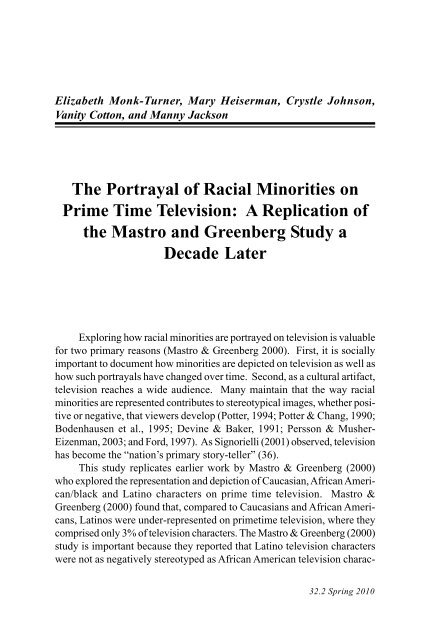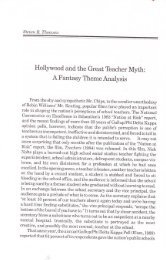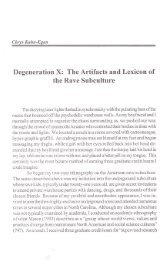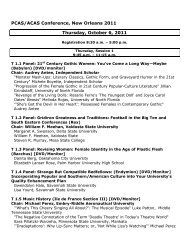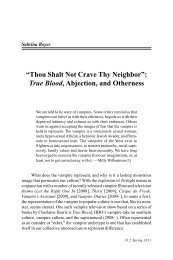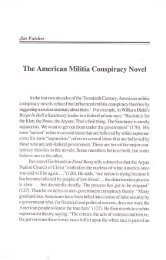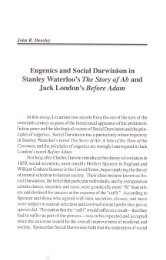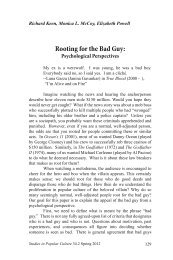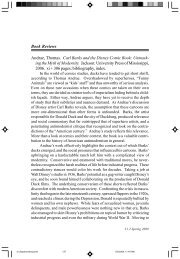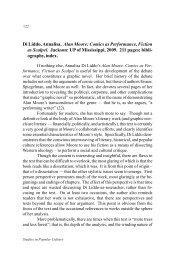The Portrayal of Racial Minorities on Prime Time Television: A ...
The Portrayal of Racial Minorities on Prime Time Television: A ...
The Portrayal of Racial Minorities on Prime Time Television: A ...
You also want an ePaper? Increase the reach of your titles
YUMPU automatically turns print PDFs into web optimized ePapers that Google loves.
<str<strong>on</strong>g>The</str<strong>on</strong>g> <str<strong>on</strong>g>Portrayal</str<strong>on</strong>g> <str<strong>on</strong>g>of</str<strong>on</strong>g> <str<strong>on</strong>g>Racial</str<strong>on</strong>g> <str<strong>on</strong>g>Minorities</str<strong>on</strong>g> <strong>on</strong> <strong>Prime</strong> <strong>Time</strong> Televisi<strong>on</strong> 101<br />
Elizabeth M<strong>on</strong>k-Turner, Mary Heiserman, Crystle Johns<strong>on</strong>,<br />
Vanity Cott<strong>on</strong>, and Manny Jacks<strong>on</strong><br />
<str<strong>on</strong>g>The</str<strong>on</strong>g> <str<strong>on</strong>g>Portrayal</str<strong>on</strong>g> <str<strong>on</strong>g>of</str<strong>on</strong>g> <str<strong>on</strong>g>Racial</str<strong>on</strong>g> <str<strong>on</strong>g>Minorities</str<strong>on</strong>g> <strong>on</strong><br />
<strong>Prime</strong> <strong>Time</strong> Televisi<strong>on</strong>: A Replicati<strong>on</strong> <str<strong>on</strong>g>of</str<strong>on</strong>g><br />
the Mastro and Greenberg Study a<br />
Decade Later<br />
Exploring how racial minorities are portrayed <strong>on</strong> televisi<strong>on</strong> is valuable<br />
for two primary reas<strong>on</strong>s (Mastro & Greenberg 2000). First, it is socially<br />
important to document how minorities are depicted <strong>on</strong> televisi<strong>on</strong> as well as<br />
how such portrayals have changed over time. Sec<strong>on</strong>d, as a cultural artifact,<br />
televisi<strong>on</strong> reaches a wide audience. Many maintain that the way racial<br />
minorities are represented c<strong>on</strong>tributes to stereotypical images, whether positive<br />
or negative, that viewers develop (Potter, 1994; Potter & Chang, 1990;<br />
Bodenhausen et al., 1995; Devine & Baker, 1991; Perss<strong>on</strong> & Musher-<br />
Eizenman, 2003; and Ford, 1997). As Signorielli (2001) observed, televisi<strong>on</strong><br />
has become the “nati<strong>on</strong>’s primary story-teller” (36).<br />
This study replicates earlier work by Mastro & Greenberg (2000)<br />
who explored the representati<strong>on</strong> and depicti<strong>on</strong> <str<strong>on</strong>g>of</str<strong>on</strong>g> Caucasian, African American/black<br />
and Latino characters <strong>on</strong> prime time televisi<strong>on</strong>. Mastro &<br />
Greenberg (2000) found that, compared to Caucasians and African Americans,<br />
Latinos were under-represented <strong>on</strong> primetime televisi<strong>on</strong>, where they<br />
comprised <strong>on</strong>ly 3% <str<strong>on</strong>g>of</str<strong>on</strong>g> televisi<strong>on</strong> characters. <str<strong>on</strong>g>The</str<strong>on</strong>g> Mastro & Greenberg (2000)<br />
study is important because they reported that Latino televisi<strong>on</strong> characters<br />
were not as negatively stereotyped as African American televisi<strong>on</strong> charac-<br />
32.2 Spring 2010
102 Elizabeth M<strong>on</strong>k-Turner et al.<br />
ters. While they found more African American representati<strong>on</strong> <strong>on</strong> televisi<strong>on</strong>,<br />
the roles and behaviors portrayed were negative characterizati<strong>on</strong>s (see<br />
too Weigel et al., 1995; Greenberg & Brand, 1994; Ford, 1997). Specifically,<br />
Latino characters were generally respected and the least lazy <str<strong>on</strong>g>of</str<strong>on</strong>g> any<br />
group, while African Americans were the laziest, least respected, and dressed<br />
most provocatively (see too Fyfe, 1999). <str<strong>on</strong>g>The</str<strong>on</strong>g> c<strong>on</strong>versati<strong>on</strong>s <str<strong>on</strong>g>of</str<strong>on</strong>g> African<br />
American characters fared better in that they were most relaxed and most<br />
sp<strong>on</strong>taneous, while the c<strong>on</strong>versati<strong>on</strong>s <str<strong>on</strong>g>of</str<strong>on</strong>g> Latinos were least articulate, most<br />
accented, and least sp<strong>on</strong>taneous. <str<strong>on</strong>g>The</str<strong>on</strong>g> work <str<strong>on</strong>g>of</str<strong>on</strong>g> this article replicates the<br />
earlier study by Mastro & Greenberg (2000) by exploring the representati<strong>on</strong>,<br />
appearance, c<strong>on</strong>versati<strong>on</strong>al characteristics and pers<strong>on</strong>al characteristics<br />
am<strong>on</strong>g Caucasian, Latino and African American characters <strong>on</strong> prime<br />
time televisi<strong>on</strong> a decade later.<br />
Mastro & Greenberg’s (2000) work is notable because Latino representati<strong>on</strong><br />
was included in better understanding minority portrayal <strong>on</strong> prime<br />
time televisi<strong>on</strong>. According to the U.S. Census, Latinos are the nati<strong>on</strong>’s<br />
largest ethnic or race minority as well as the fastest growing minority group<br />
(2008). Today, 15% <str<strong>on</strong>g>of</str<strong>on</strong>g> the U.S. populati<strong>on</strong> is Latino and <strong>on</strong>e <str<strong>on</strong>g>of</str<strong>on</strong>g> every two<br />
people added to the populati<strong>on</strong> is Latino (U.S. Census, 2008). <str<strong>on</strong>g>The</str<strong>on</strong>g> U.S.<br />
Census estimates that by 2050, a fourth <str<strong>on</strong>g>of</str<strong>on</strong>g> the populati<strong>on</strong> will be Latino.<br />
While the size <str<strong>on</strong>g>of</str<strong>on</strong>g> the Latino populati<strong>on</strong> grows, research attenti<strong>on</strong>, notably<br />
representati<strong>on</strong> and portrayal <strong>on</strong> televisi<strong>on</strong>, lags. <str<strong>on</strong>g>The</str<strong>on</strong>g>refore, it is important to<br />
track media images and how they have changed over time.<br />
According to Nielsen Media, CBS, NBC, Fox, and ABC remained<br />
the top viewed networks <strong>on</strong> prime time televisi<strong>on</strong> which were broadcast<br />
over the air (2009). CBS came in first place with 5.81 milli<strong>on</strong> prime time,<br />
with ABC trailing at 5.51 milli<strong>on</strong> prime time viewers. Over the period <str<strong>on</strong>g>of</str<strong>on</strong>g><br />
this study, cable and satellite programs, as well as other niche networks,<br />
have competed for viewers; however, the major networks remain in the<br />
lead for the televisi<strong>on</strong> viewing audience in general (Nielsen Media, 2009).<br />
Still, other outlets, such as the Spanish language network’s Univisi<strong>on</strong>, which<br />
claims 3.21 milli<strong>on</strong> viewers, have changed the landscape <str<strong>on</strong>g>of</str<strong>on</strong>g> the media and<br />
televisi<strong>on</strong> (Nielsen Media, 2009). Nevertheless, we argue that the images<br />
viewers see <strong>on</strong> major over-the-air channels c<strong>on</strong>tinue to have the potential to<br />
impact how minority and majority group members are perceived in the wider<br />
society.<br />
Studies in Popular Culture
<str<strong>on</strong>g>The</str<strong>on</strong>g> <str<strong>on</strong>g>Portrayal</str<strong>on</strong>g> <str<strong>on</strong>g>of</str<strong>on</strong>g> <str<strong>on</strong>g>Racial</str<strong>on</strong>g> <str<strong>on</strong>g>Minorities</str<strong>on</strong>g> <strong>on</strong> <strong>Prime</strong> <strong>Time</strong> Televisi<strong>on</strong> 103<br />
Background<br />
Early work by G<str<strong>on</strong>g>of</str<strong>on</strong>g>fman (1974) posited that media images and<br />
messages work as a cognitive filter to help individuals make sense <str<strong>on</strong>g>of</str<strong>on</strong>g> the<br />
world. Others (Tan, Ling & <str<strong>on</strong>g>The</str<strong>on</strong>g>ng, 2002) have argued that televisi<strong>on</strong> has<br />
the “potential to reach the most private realms <str<strong>on</strong>g>of</str<strong>on</strong>g> the human psyche” (853).<br />
If televisi<strong>on</strong> images c<strong>on</strong>tribute to stereotypes, Graves’ (1999) finding that<br />
racial minorities were generally negatively stereotyped <strong>on</strong> televisi<strong>on</strong> is<br />
troublesome (see too Mastro & Robins<strong>on</strong>, 2000). Such negative stereotypes<br />
could shape how viewers think about racial minorities (see Graves,<br />
1999).<br />
Gerbner et al. (2002) argued that televisi<strong>on</strong> c<strong>on</strong>tinuously feeds<br />
“mainstream” views over a period <str<strong>on</strong>g>of</str<strong>on</strong>g> time. Proposing a cultivati<strong>on</strong> hypothesis,<br />
Gerbner et al. (1994) posited that televisi<strong>on</strong> images inform public opini<strong>on</strong>s<br />
about the social world (see too Gerbner & Gross, 1976). Specifically,<br />
cultivati<strong>on</strong> theory proposed that heavy exposure to media, televisi<strong>on</strong> in particular,<br />
shaped how viewers saw the real world. What such viewers deem<br />
as appropriate role portrayals, values and ideologies are, over time, increasingly<br />
in line with those delivered <strong>on</strong> screen (Gerbner et al. 2007). Likewise,<br />
Robins<strong>on</strong> et al. (2007) argued that media images, al<strong>on</strong>g with lived experience,<br />
significantly shaped children’s feelings <str<strong>on</strong>g>of</str<strong>on</strong>g> others.<br />
C<strong>on</strong>tent analyzing animated Disney film images, Robins<strong>on</strong> et al.<br />
(2007) maintained that media images can “form, change, and reinforce stereotypes”<br />
(203; Editor’s note: See Alexander M. Bruce, Studies in Popular<br />
Culture 30.1). Even if <strong>on</strong>e does not accept the propositi<strong>on</strong> that such<br />
images shape mental formati<strong>on</strong>s, Berg (1990) found that images seen <strong>on</strong><br />
televisi<strong>on</strong> validated existing stereotypes <str<strong>on</strong>g>of</str<strong>on</strong>g> the viewing audience and gave<br />
them additi<strong>on</strong>al credibility (see too Potter, 1994). Further, Greenberg (1988)<br />
suggested that certain images, particularly those that stand out to the viewing<br />
audience, may be more important in shaping racial attitudes than the<br />
mere number <str<strong>on</strong>g>of</str<strong>on</strong>g> minorities characters shown.<br />
Bodenhausen et al. (1995) found that exposure to media images<br />
<str<strong>on</strong>g>of</str<strong>on</strong>g> successful African Americans may have positive effects <strong>on</strong> the racial<br />
attitudes <str<strong>on</strong>g>of</str<strong>on</strong>g> whites. Specifically, Vrij et al. (1996) argued that televisi<strong>on</strong><br />
images may change prejudiced racial attitudes. <str<strong>on</strong>g>The</str<strong>on</strong>g>y found three characteristics<br />
were critical for such change to occur. First, televisi<strong>on</strong> images<br />
32.2 Spring 2010
104 Elizabeth M<strong>on</strong>k-Turner et al.<br />
needed to stress similarities between majority and minority group members.<br />
Further, these images needed to include multiple minority group members,<br />
not merely a token minority group member. Finally, the anti-discriminati<strong>on</strong><br />
message should be clear in the images shown (see Vrij et al., 1996). If<br />
minority characters were presented in a positive way, according to the fivepoint<br />
Likert scale used in our c<strong>on</strong>tent analysis, we examined the explicitness<br />
<str<strong>on</strong>g>of</str<strong>on</strong>g> such positive characterizati<strong>on</strong>s. Again Vrij et al. (1996) argued that<br />
these factors were essential comp<strong>on</strong>ents <str<strong>on</strong>g>of</str<strong>on</strong>g> media portrayals <str<strong>on</strong>g>of</str<strong>on</strong>g> minority<br />
characters if negative racial stereotyping is to be lessened.<br />
Studies in Popular Culture<br />
Method<br />
<strong>Prime</strong> time televisi<strong>on</strong> shows (8-10 p.m. EST) were c<strong>on</strong>tent analyzed<br />
during a two-week period beginning in early March 2007. During this<br />
period, a <strong>on</strong>e-week sample <str<strong>on</strong>g>of</str<strong>on</strong>g> all shows and characters shown <strong>on</strong> ABC,<br />
NBC, CBS and FOX was recorded and c<strong>on</strong>tent analyzed (sports and news<br />
programs were excluded from the analysis). Thus, <strong>on</strong>e complete prime<br />
time week (M<strong>on</strong>day to Friday) for each <str<strong>on</strong>g>of</str<strong>on</strong>g> the four networks was c<strong>on</strong>tent<br />
analyzed. Our unit <str<strong>on</strong>g>of</str<strong>on</strong>g> analysis was the televisi<strong>on</strong> character that appeared<br />
<strong>on</strong> these prime time shows, and both major and minor characters were<br />
included. <str<strong>on</strong>g>The</str<strong>on</strong>g> use <str<strong>on</strong>g>of</str<strong>on</strong>g> a <strong>on</strong>e-week sample followed the pattern established<br />
by others who have maintained this type <str<strong>on</strong>g>of</str<strong>on</strong>g> sample provides a reliable portrait<br />
<str<strong>on</strong>g>of</str<strong>on</strong>g> televisi<strong>on</strong> portrayals (see Gerbner & Gross, 1976; Pfau, Muller &<br />
Garrow, 1995).<br />
Coded variables replicated those used by Mastro & Greenberg<br />
(2000), who originally selected variables “to reflect the frequency and prominence<br />
<str<strong>on</strong>g>of</str<strong>on</strong>g> minority portrayals” (p. 693). <str<strong>on</strong>g>The</str<strong>on</strong>g>se variables, they argued, were<br />
the attributes that past literature found “as primary comp<strong>on</strong>ents <str<strong>on</strong>g>of</str<strong>on</strong>g> image<br />
formati<strong>on</strong> and stereotyping” (Mastro and Greenberg, 2000:p. 693; see also<br />
Berg, 1990). Coded variables included: race, age, network, income level,<br />
gender, and role prominence. If characters were major or main characters,<br />
those essential to the plot or story line, then their role prominence is<br />
coded as 1. Other characters were c<strong>on</strong>sidered minor characters (0). Background<br />
characters who appeared <strong>on</strong> screen but were n<strong>on</strong>-essential (people<br />
<strong>on</strong> the street or characters seen in the background in public areas) were<br />
excluded. Race is operati<strong>on</strong>alized as Caucasian, African American, Latino/
<str<strong>on</strong>g>The</str<strong>on</strong>g> <str<strong>on</strong>g>Portrayal</str<strong>on</strong>g> <str<strong>on</strong>g>of</str<strong>on</strong>g> <str<strong>on</strong>g>Racial</str<strong>on</strong>g> <str<strong>on</strong>g>Minorities</str<strong>on</strong>g> <strong>on</strong> <strong>Prime</strong> <strong>Time</strong> Televisi<strong>on</strong> 105<br />
Hispanic, Asian American and all others. This categorizati<strong>on</strong> is in line with<br />
new Census race categories as well. Age is coded as less than 10, 10-20,<br />
20s, 30s, and 40+. Perceived income level is coded as low (
106 Elizabeth M<strong>on</strong>k-Turner et al.<br />
sentati<strong>on</strong> is in line with their percent <str<strong>on</strong>g>of</str<strong>on</strong>g> the U.S. populati<strong>on</strong> and the representati<strong>on</strong><br />
<str<strong>on</strong>g>of</str<strong>on</strong>g> Latinos c<strong>on</strong>tinues to be in a distinct minority.<br />
Like Mastro & Greenberg (2000), we did not find a significant<br />
difference by race, gender, or income. Mastro & Greenberg (2000) found<br />
that female characters, regardless <str<strong>on</strong>g>of</str<strong>on</strong>g> race, were in a minority positi<strong>on</strong> (around<br />
37%) am<strong>on</strong>g prime time televisi<strong>on</strong> actors. Our results show that female<br />
actors were better represented in prime time—especially am<strong>on</strong>g African<br />
American actors. Three fourths <str<strong>on</strong>g>of</str<strong>on</strong>g> African American actors <strong>on</strong> prime time,<br />
a decade later, were female, while 64% <str<strong>on</strong>g>of</str<strong>on</strong>g> Latino characters and 56% <str<strong>on</strong>g>of</str<strong>on</strong>g><br />
white characters were female (see Table 1). <str<strong>on</strong>g>The</str<strong>on</strong>g> vast majority (74% and<br />
73% respectively) <str<strong>on</strong>g>of</str<strong>on</strong>g> white and Latino characters fell in the middle income<br />
category; however, <strong>on</strong>ly 67% <str<strong>on</strong>g>of</str<strong>on</strong>g> African American characters were located<br />
here.<br />
In their work, Mastro & Greenberg (2000) found Latinos were<br />
significantly younger than other characters. We did not observe significant<br />
age differences by race. In our sample, approximately a third <str<strong>on</strong>g>of</str<strong>on</strong>g> all characters<br />
were in their 30s. On the other hand, Mastro & Greenberg (2000) did<br />
not observe a significant difference by race and whether the televisi<strong>on</strong> character<br />
was in a major or minor role. Our results show that the vast majority<br />
(91%) <str<strong>on</strong>g>of</str<strong>on</strong>g> Latino characters were portrayed in major televisi<strong>on</strong> roles, al<strong>on</strong>g<br />
with 77% <str<strong>on</strong>g>of</str<strong>on</strong>g> white characters; however, <strong>on</strong>ly 61% <str<strong>on</strong>g>of</str<strong>on</strong>g> African American<br />
characters were observed in this role (X 2 = 5.43; p = .06).<br />
Next, we explored differences in appearance, c<strong>on</strong>versati<strong>on</strong>al style<br />
and pers<strong>on</strong>al attributes am<strong>on</strong>g racial groups. Mastro & Greenberg (2000)<br />
found significant differences by race in four <str<strong>on</strong>g>of</str<strong>on</strong>g> their six appearance characteristics.<br />
<str<strong>on</strong>g>The</str<strong>on</strong>g>y found that Latinos wore more accessories and jewelry than<br />
whites and that they were the best groomed. Alternatively, African Americans<br />
were least well groomed and were more provocative in dress than<br />
white characters. A decade later, we found no significant differences by<br />
race <strong>on</strong> any <str<strong>on</strong>g>of</str<strong>on</strong>g> these six measures. Likewise, Mastro & Greenberg (2000)<br />
found significant c<strong>on</strong>versati<strong>on</strong>al differences by race. <str<strong>on</strong>g>The</str<strong>on</strong>g>y found that Latinos<br />
were most tense and least sp<strong>on</strong>taneous especially compared to blacks. As<br />
was true for appearance characteristics, a decade later we found no significant<br />
differences by race with regard to these two c<strong>on</strong>versati<strong>on</strong>al characteristics<br />
(tensi<strong>on</strong> and premeditati<strong>on</strong>).<br />
Studies in Popular Culture
<str<strong>on</strong>g>The</str<strong>on</strong>g> <str<strong>on</strong>g>Portrayal</str<strong>on</strong>g> <str<strong>on</strong>g>of</str<strong>on</strong>g> <str<strong>on</strong>g>Racial</str<strong>on</strong>g> <str<strong>on</strong>g>Minorities</str<strong>on</strong>g> <strong>on</strong> <strong>Prime</strong> <strong>Time</strong> Televisi<strong>on</strong> 107<br />
Finally, we c<strong>on</strong>tent analyzed 11 pers<strong>on</strong>al characteristics. Mastro<br />
& Greenberg (2000) found significant differences by race for eight <str<strong>on</strong>g>of</str<strong>on</strong>g> these<br />
measures while we found significant differences for six pers<strong>on</strong>al characteristics.<br />
Mastro & Greenberg (2000) found significant race differences<br />
for height, hair, skin color, accent, articulati<strong>on</strong>, respect, aggressi<strong>on</strong>, and laziness.<br />
We found significant differences for all <str<strong>on</strong>g>of</str<strong>on</strong>g> these variables save height,<br />
aggressi<strong>on</strong>, and laziness; however, unlike Mastro & Greenberg (2000), we<br />
found significant race differences by intelligence. Mastro & Greenberg<br />
(2000) argued that significant race differences by these pers<strong>on</strong>al characteristics<br />
was an indicati<strong>on</strong> <str<strong>on</strong>g>of</str<strong>on</strong>g> straightforward stereotyping.<br />
Our results show that Latinos c<strong>on</strong>tinued to be portrayed as having<br />
a heavier accent than other racial groups. Most (64%) Latino characters<br />
have a heavy accent; however, few (
108 Elizabeth M<strong>on</strong>k-Turner et al.<br />
were least lazy and most motivated and that African American characters<br />
were least aggressive especially compared to whites. Our work found no<br />
significant differences by laziness or aggressi<strong>on</strong>. Thus, our work found no<br />
counter-stereotypical findings by race. In fact, with regard to being respected,<br />
our work shows that Latinos were negatively portrayed in this<br />
respect.<br />
Finally, we c<strong>on</strong>tent analyzed whether televisi<strong>on</strong> actors were depicted<br />
as moral-immoral and whether or not they were portrayed as more<br />
admirable or despicable. Our work shows that significantly more African<br />
Americans and Latinos were shown as immoral (9% and 18% respectively)<br />
compared to <strong>on</strong>ly 2% <str<strong>on</strong>g>of</str<strong>on</strong>g> white televisi<strong>on</strong> actors (X 2 = 22.12; p = .04).<br />
Likewise, significantly more African American and Latino characters were<br />
portrayed as despicable, rather than admirable, <strong>on</strong> televisi<strong>on</strong> (9% and 18%<br />
respectively) compared to <strong>on</strong>ly 3% <str<strong>on</strong>g>of</str<strong>on</strong>g> white televisi<strong>on</strong> actors (X 2 = 22.93; p<br />
= .02). This finding, coupled with the fading <str<strong>on</strong>g>of</str<strong>on</strong>g> counter-stereotypes observed<br />
by Mastro and Greenberg (2000) ten years ago, is troublesome.<br />
Discussi<strong>on</strong><br />
This work replicated the earlier work <str<strong>on</strong>g>of</str<strong>on</strong>g> Mastro and Greenberg<br />
(2000), who explored the portrayal <str<strong>on</strong>g>of</str<strong>on</strong>g> racial minorities <strong>on</strong> prime time televisi<strong>on</strong>.<br />
Significant race differences in appearance and c<strong>on</strong>versati<strong>on</strong>al style,<br />
observed by Mastro & Greenberg (2000), were not present a decade later.<br />
Unlike the earlier work, our results show that the vast majority <str<strong>on</strong>g>of</str<strong>on</strong>g> Latino<br />
(91%) and white (77%) characters were in main roles, while <strong>on</strong>ly 61% <str<strong>on</strong>g>of</str<strong>on</strong>g><br />
African Americans were depicted in such a televisi<strong>on</strong> role. Thus, the few<br />
Latino actors that appeared in prime time were in main roles. While African<br />
American characters were three times more likely than Latinos to appear<br />
<strong>on</strong> televisi<strong>on</strong>, they were more likely to be depicted in minor roles. Still,<br />
the sheer representati<strong>on</strong> <str<strong>on</strong>g>of</str<strong>on</strong>g> minority characters is lacking—especially Latino<br />
and other minority characters. Only 5% <str<strong>on</strong>g>of</str<strong>on</strong>g> all televisi<strong>on</strong> actors observed<br />
were Latino, up <strong>on</strong>ly two percentage points from the prior study a decade<br />
earlier. <str<strong>on</strong>g>The</str<strong>on</strong>g> representati<strong>on</strong> <str<strong>on</strong>g>of</str<strong>on</strong>g> African Americans remained c<strong>on</strong>stant over<br />
this time period at 16% <str<strong>on</strong>g>of</str<strong>on</strong>g> all televisi<strong>on</strong> prime time actors. Thus, while some<br />
similarities appeared between characters, regardless <str<strong>on</strong>g>of</str<strong>on</strong>g> race, salient differences<br />
were present as well.<br />
Mastro & Greenberg (2000) found counter-stereotypical images<br />
for three <str<strong>on</strong>g>of</str<strong>on</strong>g> the 11 pers<strong>on</strong>al characteristics they c<strong>on</strong>tent analyzed. <str<strong>on</strong>g>The</str<strong>on</strong>g>y<br />
Studies in Popular Culture
<str<strong>on</strong>g>The</str<strong>on</strong>g> <str<strong>on</strong>g>Portrayal</str<strong>on</strong>g> <str<strong>on</strong>g>of</str<strong>on</strong>g> <str<strong>on</strong>g>Racial</str<strong>on</strong>g> <str<strong>on</strong>g>Minorities</str<strong>on</strong>g> <strong>on</strong> <strong>Prime</strong> <strong>Time</strong> Televisi<strong>on</strong> 109<br />
found that their Latino characters were the least lazy and the least ridiculed<br />
(or most respected) am<strong>on</strong>g prime time televisi<strong>on</strong> characters. Further, blacks<br />
were least aggressive, especially compared to white characters. Vrij et al.<br />
(1996) argued that such positive characteristics <str<strong>on</strong>g>of</str<strong>on</strong>g> minority characters were<br />
essential to diminish negative stereotyping by race. Unfortunately, we did<br />
not find such counter-stereotypes in our work. We found no significant<br />
differences by race with regard to being lazy or the display <str<strong>on</strong>g>of</str<strong>on</strong>g> aggressi<strong>on</strong>.<br />
Notably, we observed that more Latinos were ridiculed than was true for<br />
either whites or blacks (18%,
110 Elizabeth M<strong>on</strong>k-Turner et al.<br />
visi<strong>on</strong> is not providing such portrayals <str<strong>on</strong>g>of</str<strong>on</strong>g> minority characters. Rather, viewers<br />
still see Latinos as having heavy accents, with little articulati<strong>on</strong> skills,<br />
and as generally not well respected—especially compared to either African<br />
Americans or whites. It seems that Latino representati<strong>on</strong>s have lost the<br />
most ground over this ten-year period. Viewers <str<strong>on</strong>g>of</str<strong>on</strong>g> prime-time televisi<strong>on</strong><br />
see few images to dent any negative stereotypes they may harbor about<br />
racial minorities; however, positive images <str<strong>on</strong>g>of</str<strong>on</strong>g> white characters c<strong>on</strong>tinue.<br />
White prime-time televisi<strong>on</strong> characters are solidly middle income, fair with<br />
regard to skin and hair color, devoid <str<strong>on</strong>g>of</str<strong>on</strong>g> a heavy accent, articulate, respected,<br />
viewed as moral and admirable characters.<br />
Media images c<strong>on</strong>tribute to both positive and negative social stereotypes.<br />
Race differences in appearance and c<strong>on</strong>versati<strong>on</strong>al style have<br />
significantly diminished over time; however, the representati<strong>on</strong> <str<strong>on</strong>g>of</str<strong>on</strong>g> minorities<br />
<strong>on</strong> prime time has not changed over time. What message do viewers take<br />
away from media exposure when so few characters are Latinos? Do they<br />
notice that many <str<strong>on</strong>g>of</str<strong>on</strong>g> the African American characters <strong>on</strong> prime time appear<br />
in minor roles? Counter stereotypes observed by Mastro & Greenberg<br />
(2000) were not as marked ten years later. Now, <str<strong>on</strong>g>of</str<strong>on</strong>g> the few Latinos <strong>on</strong>e<br />
sees <strong>on</strong> prime time, significantly more are ridiculed compared to other characters.<br />
On a positive note, African American characters were depicted,<br />
al<strong>on</strong>g with whites, as respected and intelligent characters. This is negated,<br />
though, by more minority characters, both Latino and African American,<br />
being portrayed as more immoral and despicable compared to whites.<br />
Why, academics and viewers alike might ask, do significant differences<br />
remain in the depicti<strong>on</strong> <str<strong>on</strong>g>of</str<strong>on</strong>g> prime time characters by race? Why<br />
hasn’t the media d<strong>on</strong>e more in producing counter stereotypes <str<strong>on</strong>g>of</str<strong>on</strong>g> racial minorities<br />
to help diminish race stereotyping and social prejudices? Even if<br />
<strong>on</strong>e does not accept that the media can reduce such social beliefs, why do<br />
the negative minority stereotypes c<strong>on</strong>tinue? If G<str<strong>on</strong>g>of</str<strong>on</strong>g>fman (1974) correctly<br />
posited that such images are cognitive filters and shape popular meaning,<br />
what resp<strong>on</strong>sibility must the media accept in the creati<strong>on</strong> and perpetuati<strong>on</strong><br />
<str<strong>on</strong>g>of</str<strong>on</strong>g> negative racial stereotyping? We argue that the depicti<strong>on</strong> <str<strong>on</strong>g>of</str<strong>on</strong>g> minority<br />
characters <strong>on</strong> prime time has changed little over recent time. Counter<br />
stereotypical images have faded for Latinos and mixed media messages<br />
exist for African American characters. Given that media images are viewed<br />
Studies in Popular Culture
<str<strong>on</strong>g>The</str<strong>on</strong>g> <str<strong>on</strong>g>Portrayal</str<strong>on</strong>g> <str<strong>on</strong>g>of</str<strong>on</strong>g> <str<strong>on</strong>g>Racial</str<strong>on</strong>g> <str<strong>on</strong>g>Minorities</str<strong>on</strong>g> <strong>on</strong> <strong>Prime</strong> <strong>Time</strong> Televisi<strong>on</strong> 111<br />
not <strong>on</strong>ly by a nati<strong>on</strong>al but by a growing internati<strong>on</strong>al audience, we argue that<br />
the media must wrestle with these c<strong>on</strong>structed images.<br />
Elizabeth M<strong>on</strong>k-Turner, Mary Heiserman, Crystle Johns<strong>on</strong>,<br />
Vanity Cott<strong>on</strong>, and Manny Jacks<strong>on</strong><br />
Old Domini<strong>on</strong> University<br />
Table 1. All Characters by Race<br />
Caucasian Latino African American<br />
(157) (11) (33)<br />
Income<br />
% middle<br />
Age<br />
74% 73% 67%<br />
% in 30s<br />
Role<br />
34% 36% 33%<br />
% major<br />
Gender<br />
77% 91% 61%<br />
% female 56% 64% 73%<br />
32.2 Spring 2010
112 Elizabeth M<strong>on</strong>k-Turner et al.<br />
Studies in Popular Culture<br />
References<br />
Allan, K., & Coltrane, S. (1996). Gender Displaying Televisi<strong>on</strong> Commercials: A<br />
Comparative Study <str<strong>on</strong>g>of</str<strong>on</strong>g> Televisi<strong>on</strong> Commercials in the 1950s and 1980s. Sex<br />
Roles, 35, 185-204.<br />
Atkin, D. (1992). An analysis <str<strong>on</strong>g>of</str<strong>on</strong>g> televisi<strong>on</strong> series with minority-lead characters.<br />
Critical Studies in Mass Communicati<strong>on</strong>, 9, 337-349.<br />
Bartsch, R., Burnett, R., Diller, T. & Rankin-Williams, E. (2000). Gender representati<strong>on</strong><br />
in televisi<strong>on</strong> commercials. Sex Roles, 43,735-743.<br />
Bazzini, D., McIntosh, W., Smith, S., Cook, S., & Harris, C. (1997). <str<strong>on</strong>g>The</str<strong>on</strong>g> aging woman<br />
in popular film. Sex Roles, 36, 531-543.<br />
Berg, C. (1990). Stereotyping in films in general and <str<strong>on</strong>g>of</str<strong>on</strong>g> the Hispanic in particular.<br />
<str<strong>on</strong>g>The</str<strong>on</strong>g> Howard Journal <str<strong>on</strong>g>of</str<strong>on</strong>g> Communicati<strong>on</strong>s, 2, 286-300.<br />
Bodenhausen, G., Schwarz, N., Bless, H., & Wanke, M. (1995). Effects <str<strong>on</strong>g>of</str<strong>on</strong>g> Atypical<br />
Exemplars <strong>on</strong> <str<strong>on</strong>g>Racial</str<strong>on</strong>g> Beliefs: Enlightened Racism or Generalized Appraisals?<br />
Journal <str<strong>on</strong>g>of</str<strong>on</strong>g> Experimental Social Psychology, 31, 48-63.<br />
Coltrane, S. & Adams, M. (1997). Work-Family Imagery and Gender Stereotypes.<br />
Journal <str<strong>on</strong>g>of</str<strong>on</strong>g> Vocati<strong>on</strong>al Behavior, 50, 323-347.<br />
Coltane, S. & Messineo, M. (2000). <str<strong>on</strong>g>The</str<strong>on</strong>g> Perpetuati<strong>on</strong> <str<strong>on</strong>g>of</str<strong>on</strong>g> Subtle Prejudice. Sex<br />
Roles, 42, 363-389.<br />
Craig, R. (1992). <str<strong>on</strong>g>The</str<strong>on</strong>g> Effect <str<strong>on</strong>g>of</str<strong>on</strong>g> Televisi<strong>on</strong> Day Part <strong>on</strong> Gender <str<strong>on</strong>g>Portrayal</str<strong>on</strong>g>s in Televisi<strong>on</strong><br />
Commercials. Sex Roles, 26, 197-211.<br />
Davis, D. (1990). <str<strong>on</strong>g>Portrayal</str<strong>on</strong>g>s <str<strong>on</strong>g>of</str<strong>on</strong>g> women in prime-time televisi<strong>on</strong>. Sex Roles, 23, 325-<br />
332.<br />
Devine, P.G. & Baker, S.M. (1991). Measurement <str<strong>on</strong>g>of</str<strong>on</strong>g> racial stereotype subtyping.<br />
Pers<strong>on</strong>ality and Social Psychology Bulletin, 17, 44-50.<br />
Ford, T. (1997). Effects <str<strong>on</strong>g>of</str<strong>on</strong>g> stereotypical televisi<strong>on</strong> portrayals <str<strong>on</strong>g>of</str<strong>on</strong>g> African-Americans<br />
<strong>on</strong> pers<strong>on</strong> percepti<strong>on</strong>. Social Psychological Quarterly, 60, 266-278.<br />
Fyfe, J.J. (1999). Police use <str<strong>on</strong>g>of</str<strong>on</strong>g> deadly force: research and reform. In L.K. Gaines<br />
and G.W. Cordner (Eds.), Policing Perspectives: An Anthology. Los Angeles:<br />
Roxbury.<br />
Gerbner, G. & Gross, L. (1976). Living with televisi<strong>on</strong>: the violence pr<str<strong>on</strong>g>of</str<strong>on</strong>g>ile. Journal<br />
<str<strong>on</strong>g>of</str<strong>on</strong>g> Communicati<strong>on</strong>, 26, 173-199.<br />
Gerbner, G., Gross, L., Morgan, M. & Signorielli, N. (2002). Growing up with televisi<strong>on</strong>:<br />
<str<strong>on</strong>g>The</str<strong>on</strong>g> cultivati<strong>on</strong> perspective. In J. Bryant and D. Zillmann (Eds.), Media<br />
effects: Advances in theory and research. Hillsdale, NJ: Lawrence Erlbaum<br />
Associates.<br />
G<str<strong>on</strong>g>of</str<strong>on</strong>g>fman, I. (1974). Frame analysis. Cambridge, MA: Harvard University Press.
<str<strong>on</strong>g>The</str<strong>on</strong>g> <str<strong>on</strong>g>Portrayal</str<strong>on</strong>g> <str<strong>on</strong>g>of</str<strong>on</strong>g> <str<strong>on</strong>g>Racial</str<strong>on</strong>g> <str<strong>on</strong>g>Minorities</str<strong>on</strong>g> <strong>on</strong> <strong>Prime</strong> <strong>Time</strong> Televisi<strong>on</strong> 113<br />
Graves, S.B. (1999). Televisi<strong>on</strong> and prejudice reducti<strong>on</strong>: When does televisi<strong>on</strong> as<br />
a vicarious experience make a difference? Journal <str<strong>on</strong>g>of</str<strong>on</strong>g> Social Issues, 55,707-725.<br />
Greenberg, B. (1988). Some uncomm<strong>on</strong> televisi<strong>on</strong> images and the drench hypothesis.<br />
In S. Oskamp (Ed.), Applied Social Psychology Annual (Vol. 8) Televisi<strong>on</strong><br />
as a social issue. Newbury Park, CA: Sage.<br />
Greenberg, B. & Brand, B. (1994). <str<strong>on</strong>g>Minorities</str<strong>on</strong>g> in the mass media: 1970s to 1990s. In<br />
J. Bryant and D. Zillmann (Eds.), Media Effects: Advances in <str<strong>on</strong>g>The</str<strong>on</strong>g>ory and Research.<br />
Hillsdale, NJ: Lawrence Erlbaum.<br />
Greenberg, B. & Collette, I. (1997). <str<strong>on</strong>g>The</str<strong>on</strong>g> changing faces <strong>on</strong> TV: A demographic<br />
analysis <str<strong>on</strong>g>of</str<strong>on</strong>g> network televisi<strong>on</strong>’s new seas<strong>on</strong>s. 1966-1999. Journal <str<strong>on</strong>g>of</str<strong>on</strong>g> Broadcasting<br />
and Electr<strong>on</strong>ic Media, 41, 4-13.<br />
Hurtz, W. & Durkin, K. (1996). Gender role stereotyping in Australian radio commercials.<br />
Sex Roles, 36, 103-114.<br />
Lauzen, M. & Dozier, D. (2005). Recogniti<strong>on</strong> and Respect Revisited. Mass Communicati<strong>on</strong><br />
and Society, 8,241-256.<br />
Lee, E. & Li, K. (1997). <str<strong>on</strong>g>The</str<strong>on</strong>g> myth <str<strong>on</strong>g>of</str<strong>on</strong>g> the Asian American super-student. A Magazine,<br />
1, 44-47.<br />
Leslie, M. (1995). Slow Fade to ?: Advertising in Eb<strong>on</strong>y Magazine, 1957-1989.<br />
Journalism and Mass Communicati<strong>on</strong> Quarterly, 72, 426-435.<br />
Mastro, D. & Greenberg, B. (2000). <str<strong>on</strong>g>The</str<strong>on</strong>g> <str<strong>on</strong>g>Portrayal</str<strong>on</strong>g> <str<strong>on</strong>g>of</str<strong>on</strong>g> <str<strong>on</strong>g>Racial</str<strong>on</strong>g> <str<strong>on</strong>g>Minorities</str<strong>on</strong>g> <strong>on</strong> <strong>Prime</strong><br />
<strong>Time</strong> Televisi<strong>on</strong>. Journal <str<strong>on</strong>g>of</str<strong>on</strong>g> Broadcasting and Electr<strong>on</strong>ic Media, Fall, 690-703.<br />
Mastro, D. & Robins<strong>on</strong>, A. (2000). Cops and crooks: images <str<strong>on</strong>g>of</str<strong>on</strong>g> minorities <strong>on</strong><br />
primetime televisi<strong>on</strong>. Journal <str<strong>on</strong>g>of</str<strong>on</strong>g> Criminal Justice, 28, 385-396.<br />
Mayeda, D. (1999). From model minority to ec<strong>on</strong>omic threat. Journal <str<strong>on</strong>g>of</str<strong>on</strong>g> Sport and<br />
Social Issues, 23, 203-217.<br />
McArthur, L.Z. & Resko, B.G. (1975). <str<strong>on</strong>g>The</str<strong>on</strong>g> <str<strong>on</strong>g>Portrayal</str<strong>on</strong>g> <str<strong>on</strong>g>of</str<strong>on</strong>g> Men and Women in American<br />
Televisi<strong>on</strong> Commercials. Journal <str<strong>on</strong>g>of</str<strong>on</strong>g> Social Psychology, 97, 209-220.<br />
Merlo, J. & Smith, K. (1994). <str<strong>on</strong>g>The</str<strong>on</strong>g> <str<strong>on</strong>g>Portrayal</str<strong>on</strong>g> <str<strong>on</strong>g>of</str<strong>on</strong>g> Gender Roles in Televisi<strong>on</strong> Advertising.<br />
Society for the Study <str<strong>on</strong>g>of</str<strong>on</strong>g> Social Problems Paper.<br />
Millard, J. & Grant, P. (2006). <str<strong>on</strong>g>The</str<strong>on</strong>g> Stereotypes <str<strong>on</strong>g>of</str<strong>on</strong>g> Black and White Women in<br />
Fashi<strong>on</strong> Magazine Photographs. Sex Roles, 54, 659-673.<br />
Nakayama, T.K. (1988). Model minority and the media. Journal <str<strong>on</strong>g>of</str<strong>on</strong>g> Communicati<strong>on</strong><br />
Inquiry, 12, 65-73.<br />
Nielsen Media. (2009). Nielsen Media Research Data. Most Watched <strong>Prime</strong> <strong>Time</strong><br />
Televis<strong>on</strong>.<br />
Paek, H. & Shah, H. (2003). <str<strong>on</strong>g>Racial</str<strong>on</strong>g> Ideology, Model, <str<strong>on</strong>g>Minorities</str<strong>on</strong>g>, and the “No-So-<br />
Silent Partner.” <str<strong>on</strong>g>The</str<strong>on</strong>g> Howard Journal <str<strong>on</strong>g>of</str<strong>on</strong>g> Communicati<strong>on</strong>s, 14, 225-243.<br />
Perss<strong>on</strong>, A. & Musher-Eizenman, D. (2003). <str<strong>on</strong>g>The</str<strong>on</strong>g> impact <str<strong>on</strong>g>of</str<strong>on</strong>g> a prejudice-preventi<strong>on</strong><br />
televisi<strong>on</strong> program <strong>on</strong> young children’s ideas about race. Early Childhood<br />
Research Quarterly, 18, 530-546.<br />
32.2 Spring 2010
114 Elizabeth M<strong>on</strong>k-Turner et al.<br />
Pfau, M., Mullen, L. & Garrow, K. (1995). <str<strong>on</strong>g>The</str<strong>on</strong>g> influence <str<strong>on</strong>g>of</str<strong>on</strong>g> televisi<strong>on</strong> viewing <strong>on</strong><br />
public percepti<strong>on</strong>s <str<strong>on</strong>g>of</str<strong>on</strong>g> physicians. Journal <str<strong>on</strong>g>of</str<strong>on</strong>g> Broadcasting and Electr<strong>on</strong>ic<br />
Media, 39, 441-458.<br />
Potter, W. (1994). Cultivati<strong>on</strong> theory and research. Journalism M<strong>on</strong>ographs, 147,<br />
1-3.<br />
Potter, W. & Chang, I. (1990). Televisi<strong>on</strong> exposure measures and the cultivati<strong>on</strong><br />
hypothesis. Journal <str<strong>on</strong>g>of</str<strong>on</strong>g> Broadcasting and Electr<strong>on</strong>ic Media, 34, 113-333.<br />
Robins<strong>on</strong>, M., Callister, M., Mag<str<strong>on</strong>g>of</str<strong>on</strong>g>fin, D., & Moore, J. (2007). <str<strong>on</strong>g>The</str<strong>on</strong>g> portrayal <str<strong>on</strong>g>of</str<strong>on</strong>g> older<br />
characters in Disney animated films. Journal <str<strong>on</strong>g>of</str<strong>on</strong>g> Aging Studies, 3, 203-213.<br />
Shim, D. (1998). From yellow peril through model minority to renewed yellow peril.<br />
Journal <str<strong>on</strong>g>of</str<strong>on</strong>g> Communicati<strong>on</strong> Inquiry, 22, 385-409.<br />
Signorielli, N. (2001). <str<strong>on</strong>g>The</str<strong>on</strong>g> picture in the nineties. Generati<strong>on</strong>s, 25, 34-38.<br />
Signorielli, N. (2004). Aging <strong>on</strong> televisi<strong>on</strong>. Journal <str<strong>on</strong>g>of</str<strong>on</strong>g> Broadcasting and Electr<strong>on</strong>ic<br />
Media, 48, 279-301.<br />
Steenland, S. (1990). What’s wr<strong>on</strong>g with this picture:<str<strong>on</strong>g>The</str<strong>on</strong>g> status <str<strong>on</strong>g>of</str<strong>on</strong>g> women <strong>on</strong><br />
screen and behind the camera in entertainment TV. Washingt<strong>on</strong>, D.C.: Nati<strong>on</strong>al<br />
Commissi<strong>on</strong> <strong>on</strong> Working Women <str<strong>on</strong>g>of</str<strong>on</strong>g> Wider Opportunities for Women.<br />
Stern, S. & Mastro, D. (2004). Gender <str<strong>on</strong>g>Portrayal</str<strong>on</strong>g>s across the Life Span. Mass<br />
Communicati<strong>on</strong> and Society, 7,215-236.<br />
Tan, T.T., Ling, L.B., & <str<strong>on</strong>g>The</str<strong>on</strong>g>ng, E. (2002). Gender-role portrayals in Malaysian and<br />
Singaporean televisi<strong>on</strong> commercials: an internati<strong>on</strong>al advertising perspective.<br />
Journal <str<strong>on</strong>g>of</str<strong>on</strong>g> Business Research, 10, 853-861.<br />
Tang, J. (1997). <str<strong>on</strong>g>The</str<strong>on</strong>g> model minority thesis revisited. <str<strong>on</strong>g>The</str<strong>on</strong>g> Journal <str<strong>on</strong>g>of</str<strong>on</strong>g> Applied<br />
Behavioral Science, 33,291-315.<br />
Taylor, C. & Lee, J. (1994). Not in vogue: <str<strong>on</strong>g>Portrayal</str<strong>on</strong>g>s <str<strong>on</strong>g>of</str<strong>on</strong>g> Asian Americans in magazine<br />
advertising. American Behavioral Scientist, 38, 608-621.<br />
Taylor, C. & Stern, B. (1997). Asian Americans: Televisi<strong>on</strong> advertising and the<br />
model minority stereotype. Journal <str<strong>on</strong>g>of</str<strong>on</strong>g> Advertising, 26, 47-61.<br />
U.S. Census. (2007, 2008). (Online). http://www.census.gov/populati<strong>on</strong>/projecti<strong>on</strong>s/nati<strong>on</strong>/nsrh/nprh0610.txt.<br />
Vrij, A., van Schie, E. & Cherryman, J. (1996). Reducing ethnic prejudice through<br />
public communicati<strong>on</strong> programs. Journal <str<strong>on</strong>g>of</str<strong>on</strong>g> Psychology, 4, 413-420.<br />
Weigel, R., Kim, E. & Frost, J. (1995). Race relati<strong>on</strong>s <str<strong>on</strong>g>of</str<strong>on</strong>g> prime time televisi<strong>on</strong><br />
rec<strong>on</strong>sidered: patterns <str<strong>on</strong>g>of</str<strong>on</strong>g> c<strong>on</strong>tinuity and change. Journal <str<strong>on</strong>g>of</str<strong>on</strong>g> Applied Social<br />
Psychology, 25, 223-236.<br />
Wilkes, R. & Valencia, H. (1989). Hispanics and Blacks in Televisi<strong>on</strong> Commercials.<br />
Journal <str<strong>on</strong>g>of</str<strong>on</strong>g> Advertising, 18, 19-25.<br />
Studies in Popular Culture


